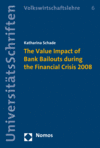Zusammenfassung
Die Arbeit beschäftigt sich mit der Schuldenüberhangtheorie von Myers (1977) im Kontext der Bankenrettungsmaßnahmen nach der Insolvenz von Lehman Brothers Inc. im Herbst 2008. Nachdem theoretisch hergeleitet wurde, wie es nach einem externen Schock im Bankensektor zu einem Schuldenüberhang kommen konnte und welche Auswirkungen dieser auf die Buch- und Marktwerte der einzelnen Eigen- und Fremdkapitalpositionen sowie CDS-Kontrakte zur Absicherung des Ausfallrisikos der Bank hat, wird zunächst im Modellkontext abgeleitet, welche Wertänderungen sich durch verschiedene Rettungsmaßnahmen ergeben müssten. Hierbei wird unterschieden, ob die Bank zuvor unter einem Schuldenüberhang litt oder nicht und ob die Rettungsmaßnahme den Schuldenüberhang aufgelöst hat oder nicht. Die Ergebnisse werden anschließend empirisch getestet, indem mittels einer Ereignisstudie die Auswirkung auf Aktienkurse und CDS-Spreads untersucht wird.
Abstract
This book analyses bank rescue measures implemented after Lehman Brothers Inc. went bankrupt in autumn 2008, both theoretically and empirically in the context of Myers’ debt overhang theory (1977). After having deduced theoretically how a debt overhang situation might have arisen due to an external shock in the banking sector, the author examines the impact of different forms of government intervention on the book and market values of individual debt and equity positions as well as CDS contracts used to hedge the credit risk of the bank in the context of the aforementioned model. A distinction is made between banks initially suffering from debt overhang or not and whether the bailout measure employed resolved their debt overhang or not. The results are then tested empirically by means of an event study. While the effects on a bank’s equity value are approximated based on share price reaction, the impact on its debt position is tested by the development of CDS spreads surrounding the bailout measure.
- 167–172 Bibliography 167–172

